Why Are They Called Butterflies?
The term 'butterfly' originates from the Old English word 'buttorfleoge,' a compound of 'buttor' (butter) and 'fleoge' (fly), implying a connection to butter. This etymology is prevalent in other languages, such as Dutch ('botervlieg') and German ('Butterfliege'), and may stem from the belief that butterflies resembled butter or stole milk and butter.
Additionally, the yellow hues of many butterfly species, such as the Common Brimstone (Gonepteryx rhamni), potentially influenced the name. Historical and cultural nuances that contributed to this nomenclature offer a rich tapestry of intrigue for those interested in further exploration.
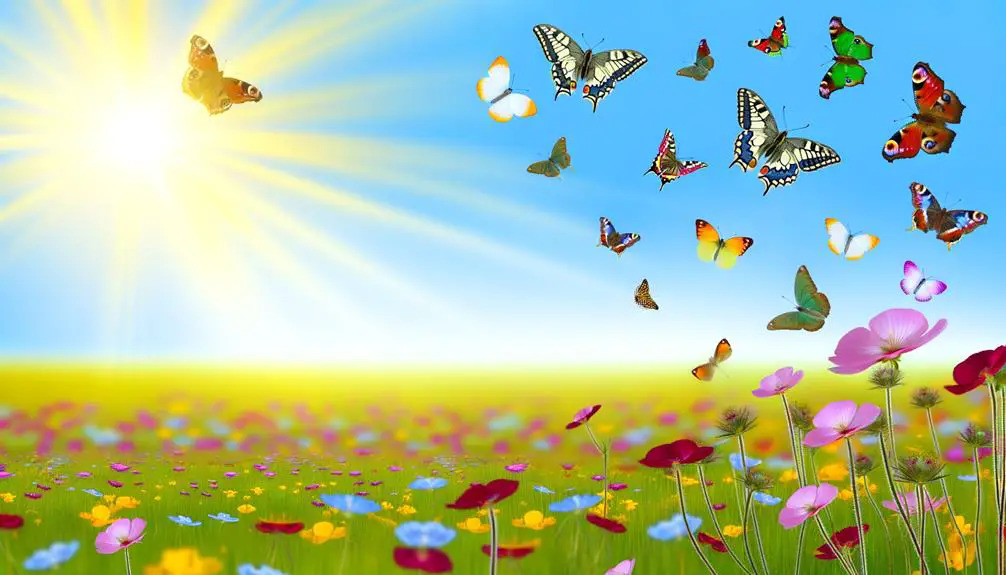
Key Takeaways
- The term 'butterfly' comes from Old English 'buttorfleoge,' meaning butter fly, likely due to their yellow coloration resembling butter.
- Theories suggest the name may relate to myths about butterflies stealing milk and butter.
- In Dutch and German, similar terms ('botervlieg' and 'Butterfliege') also mean butter fly, reinforcing the buttery appearance connection.
- The name reflects historical and cultural perceptions, showing the interplay between human observation and language evolution.
Etymology of Butterfly
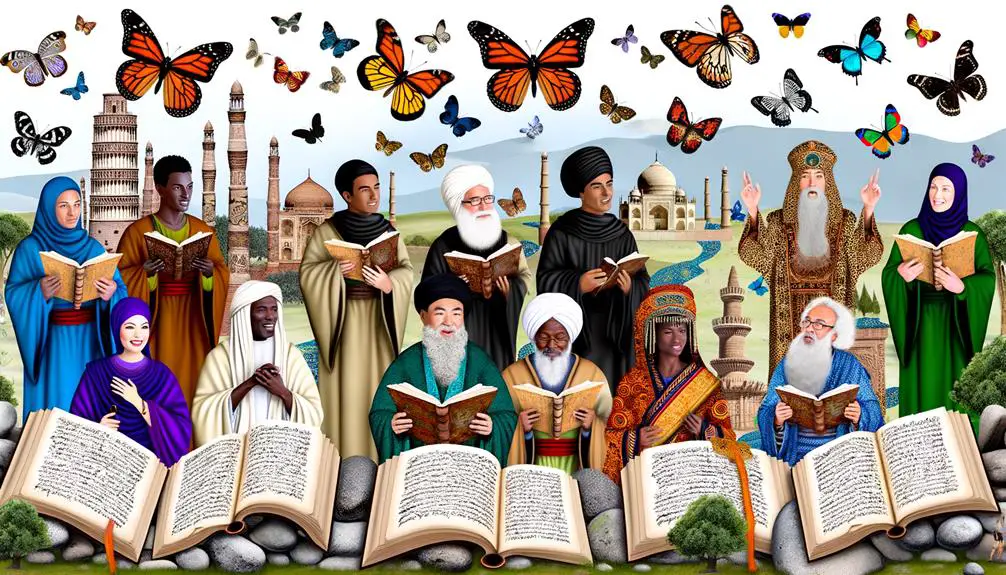
The term 'butterfly' is derived from the Old English word 'buttorfleoge,' which is believed to reference the butter-colored wings of certain species.
This nomenclature can be traced back to medieval Europe where the yellow hue of some butterflies, particularly the Brimstone butterfly (Gonepteryx rhamni), likely influenced this etymology.
Linguistic scholars suggest that the term evolved through various languages, including Dutch 'botervlieg' and German 'Butterfliege,' reinforcing the connection to the buttery appearance.
Additionally, the suffix 'fleoge' translates to 'fly,' accurately describing these insects' flight capabilities.
Consequently, the etymological roots of 'butterfly' encompass both visual and functional attributes, contributing to our modern understanding of these diverse and colorful lepidopterans.
Ancient Myths and Legends
Rooted in various ancient cultures, myths and legends surrounding butterflies often imbue these insects with symbolic significance and mystical qualities.
In Greek mythology, butterflies were seen as representations of the human soul, with the word 'psyche' meaning both 'butterfly' and 'soul.'
Similarly, in Aztec culture, butterflies symbolized the souls of warriors who had fallen in battle.
In Japanese folklore, butterflies are considered the personification of a person's soul, whether living or deceased.
These diverse interpretations underscore the butterfly's role as a bridge between the tangible world and the spiritual domain.
Such symbolic attributions offer insight into why butterflies are often associated with transformation, resurrection, and the ephemeral nature of life across different cultural narratives.
Old English Origins
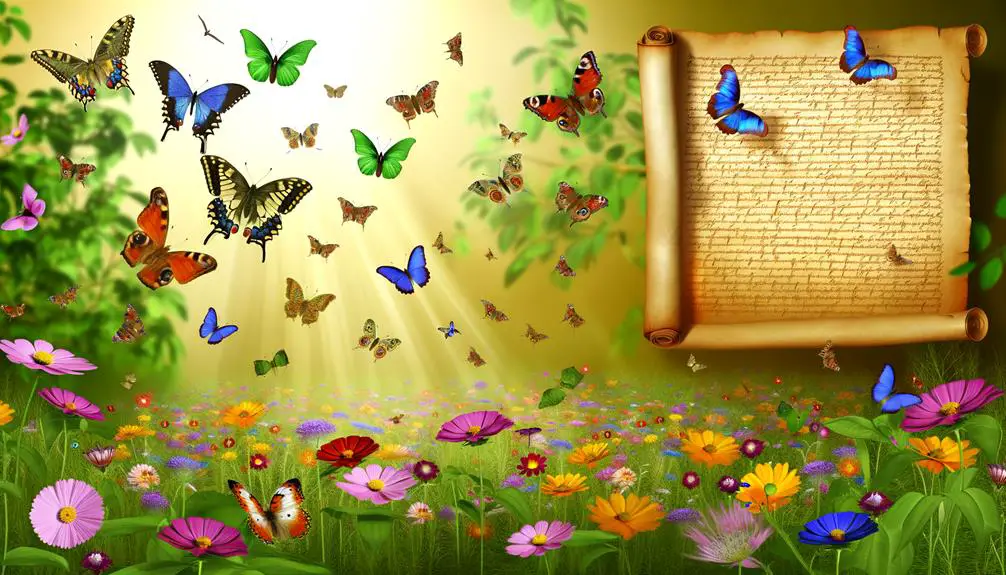
The term 'butterfly' finds its roots in the Old English word 'buttorfleoge', which itself is a compound of 'buttor' (butter) and 'fleoge' (fly).
Over the centuries, linguistic evolution has transformed 'buttorfleoge' into the modern English 'butterfly', reflecting phonetic and orthographic changes typical in the development of the English language.
This etymological journey illustrates the dynamic nature of language and the influences that shape it over time.
Etymology of 'Butterfloege'
Originating from Old English, the word 'Butterfloege' combines 'butere' (butter) and 'floege' (fly), reflecting early English speakers' observations and linguistic habits. The etymology suggests an association possibly linked to the yellowish color of some butterflies, resembling butter, or the myth that butterflies stole milk and butter. The linguistic construct is rooted in the agrarian life of early English communities, where natural phenomena were often interpreted through everyday experiences.
| Component | Meaning |
|---|---|
| Butere | Butter |
| Floege | Fly |
| Language | Old English |
| Context | Agrarian and Natural Observations |
This compound term highlights the descriptive nature of early English, encapsulating both visual and cultural elements in nomenclature.
Linguistic Evolution Over Time
Tracing the linguistic evolution from Old English origins, the term 'butterfloege' has undergone significant transformations influenced by phonetic shifts, morphological simplifications, and cultural interactions.
Initially, 'butterfloege' combined 'butere' (butter) and 'floege' (fly). The etymological root reflects both the creature's appearance and its fluttering motion.
Over time, phonetic shifts, such as the Great Vowel Shift, and morphological simplifications streamlined 'butterfloege' into the Middle English 'butterfli'. Additionally, interactions with Norman French and Latin introduced new linguistic structures and vocabulary, further refining the term.
Folklore and Superstitions
Frequently, butterflies have been associated with various myths and superstitions across different cultures, reflecting their enigmatic allure and transformation symbolism.
In ancient Greek mythology, butterflies were often seen as the souls of the deceased, with the Greek word for butterfly, 'psyche,' also meaning soul. In Ireland, white butterflies were believed to carry the souls of children. In Japan, butterflies symbolize the presence of departed loved ones.
Additionally, in many indigenous cultures, butterflies are considered omens or messengers of change. These beliefs underscore the butterfly's metamorphic life cycle, paralleling themes of rebirth and transcendence.
Scientific studies of these cultural associations reveal the deep psychological impact and the universal resonance of butterflies' life stages with human experiences of growth and transformation.
Butter-Colored Insects
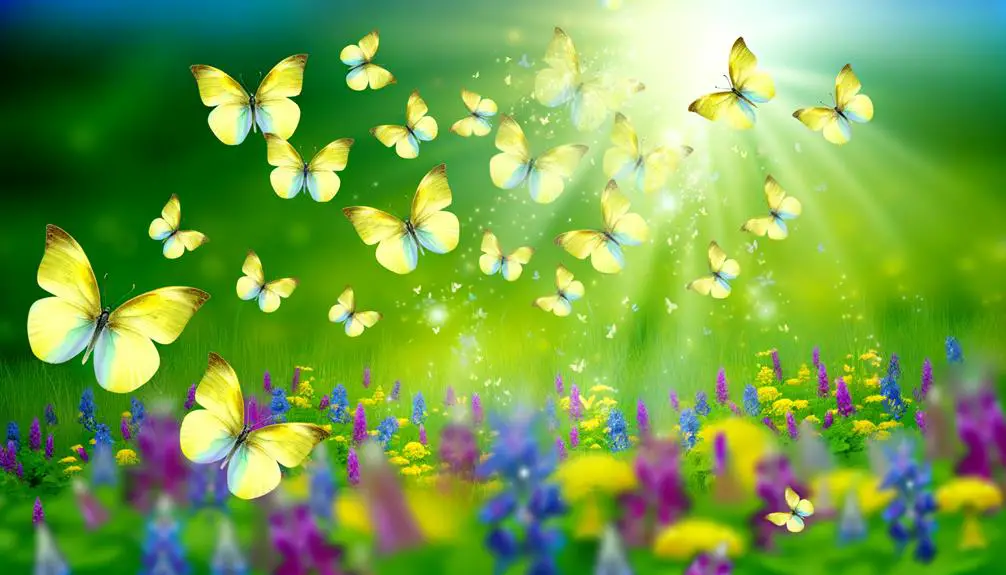
Many species of butterflies exhibit a range of yellow hues, which has historically led to the belief that their name is derived from their resemblance to butter. This chromatic similarity is particularly evident in butterflies such as the Common Brimstone (Gonepteryx rhamni), whose bright yellow wings are reminiscent of butter's coloration.
The pigment responsible for these yellow shades is often derived from carotenoids, which are sequestered from their larval host plants. Such pigments play a vital role in camouflage and mate attraction, enhancing survival and reproductive success.
The association between these insects and the color yellow is not merely anecdotal but rooted in observable, biological characteristics, thereby providing a plausible etymological link for their common name, 'butterfly.'
Metamorphosis Symbolism
The metamorphosis of butterflies, shifting from caterpillar to chrysalis to adult, serves as a powerful symbol of transformation and renewal across various cultures and scientific discourses.
This biological process entails a complete reorganization of the organism's structure and function. During the pupal stage within the chrysalis, enzymes break down the caterpillar's tissues, which are then reassembled into the intricate anatomy of the butterfly.
This profound transformation has been studied extensively in developmental biology, highlighting the genetic and hormonal mechanisms that regulate these changes.
The metamorphosis embodies a narrative of growth and adaptation, symbolizing the potential for fundamental change and new beginnings.
This scientific marvel continues to inspire and inform both biological research and metaphorical interpretations.
Cultural References
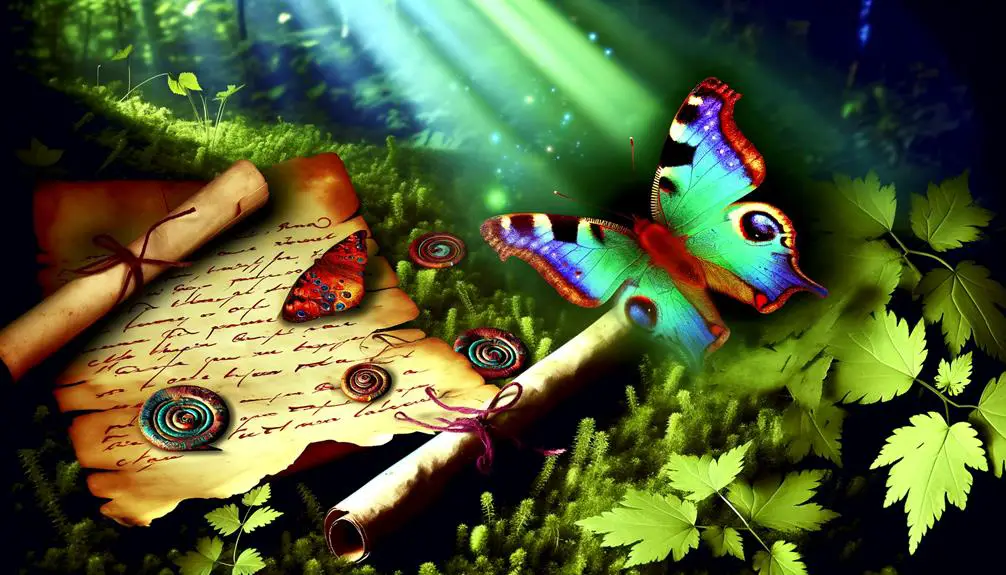
Butterflies hold significant cultural symbolism across various societies, often representing themes of transformation, beauty, and the ephemeral nature of life.
In many indigenous cultures, butterflies are seen as messengers to the spiritual world, embodying the souls of ancestors.
Japanese traditions view butterflies as symbols of marital bliss and joy.
In Western cultures, they frequently signify personal growth and the transient beauty of existence.
The ancient Greek word for butterfly, 'psyche,' also means 'soul,' reflecting its deep metaphysical connotations.
In Mexican culture, the Monarch butterfly's annual migration coincides with the Day of the Dead, symbolizing the return of departed souls.
These diverse cultural references underscore the butterfly's universal role as a powerful emblem of life's delicate and transformative journey.
Linguistic Evolution
The linguistic evolution of the term 'butterfly' encompasses its etymological origins, which trace back to Old English and its variants in other Germanic languages.
Additionally, the use of metaphor in language has influenced the name, reflecting cultural perceptions and symbolic associations.
Historical changes in nomenclature further illustrate the dynamic nature of language in describing this lepidopteran.
Etymology of "Butterfly"
Tracing the etymology of the word 'butterfly' reveals a fascinating journey through various languages and cultural interpretations.
The term is believed to originate from Old English 'buttorfleoge,' which combines 'buttor' (butter) and 'fleoge' (fly). Theories suggest this name might derive from the butter-colored appearance of some butterflies or the old belief that butterflies stole milk and butter.
Notably, similar terms appear in other Germanic languages, such as Dutch 'botervlieg' and German 'Butterfliege.' Over centuries, the word evolved while maintaining its descriptive roots.
This linguistic evolution underscores the interplay between human perception and language, illustrating how natural phenomena are interpreted and named across cultures and epochs.
Language and Metaphor
Examining the linguistic evolution of the word 'butterfly' reveals the profound role of metaphor in shaping language, as cultural interpretations and descriptive imagery deeply influence terminological development.
The term 'butterfly' likely derives from the Old English 'buttorfleoge,' combining 'buttor' (butter) and 'fleoge' (fly). This metaphorical connection may stem from the notion that certain butterflies were seen near milk and butter, or from the yellow hue of some species.
Additionally, the delicate, ephemeral nature of butterflies evokes imagery akin to the fleeting, transformative qualities often celebrated in literature and folklore.
Consequently, metaphor serves as a bridge between sensory perception and linguistic expression, encapsulating both the observable and the imaginative aspects of these enchanting insects.
Historical Name Changes
Throughout history, the nomenclature for butterflies has undergone significant transformations, reflecting diverse cultural influences and evolving linguistic frameworks. In ancient Greek, the term 'psyche' was used, signifying both 'butterfly' and 'soul,' indicating the deep symbolic associations. The Old English word 'buttorfleoge' is believed to derive from the myth that butterflies consumed butter. In Middle English, 'butterfloe' emerged, gradually evolving into the modern English 'butterfly.'
| Language | Historical Term | Modern Term |
|---|---|---|
| Ancient Greek | Psyche | Butterfly |
| Old English | Buttorfleoge | Butterfly |
| Middle English | Butterfloe | Butterfly |
These etymological shifts illustrate how linguistic evolution encapsulates historical, cultural, and mythical dimensions. Understanding these changes underscores the rich tapestry of human language development.
Global Name Variations
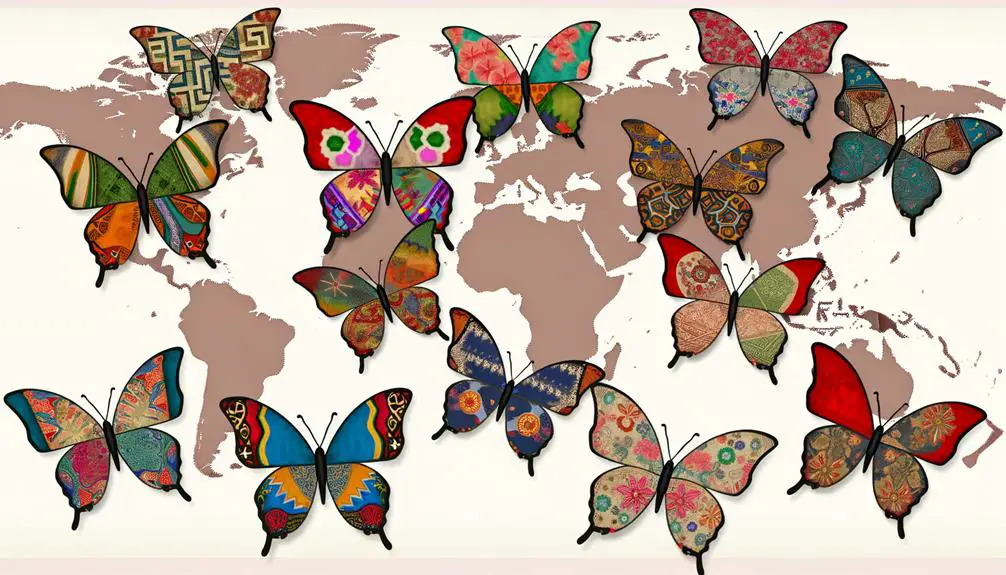
Different cultures around the world have unique names for butterflies, reflecting diverse linguistic and cultural backgrounds. These names often capture the cultural significance and local perceptions of these insects.
- Mariposa (Spanish): Derived from the phrase 'Mary goes over the rose,' evoking imagery of grace.
- Schmetterling (German): Possibly linked to old beliefs about witches transforming into butterflies.
- Papillon (French): Stemming from the Latin 'papilionem,' emphasizing the butterfly's wings.
These variations highlight the rich tapestry of human language and the importance of butterflies within different cultural contexts. They showcase how natural elements are linguistically and symbolically integrated into societies globally.
Literary Appearances
Butterflies frequently appear in literature as symbols of transformation, beauty, and ephemerality, reflecting their profound impact on human imagination and cultural narratives.
These lepidopteran insects often embody metamorphosis, as exemplified in Franz Kafka's 'The Metamorphosis,' where transformation serves as a central theme.
Additionally, their fleeting existence underscores the transient nature of beauty and life, as depicted in William Wordsworth's poetry, which often celebrates their delicate presence.
In scientific literature, butterflies also illustrate complex ecological relationships and the process of natural selection, as discussed in Charles Darwin's 'On the Origin of Species.'
Consequently, butterflies serve as multifaceted symbols, enriching literary works with layers of meaning that resonate across various cultures and epochs, thereby enhancing our understanding of natural and existential phenomena.
Modern Interpretations
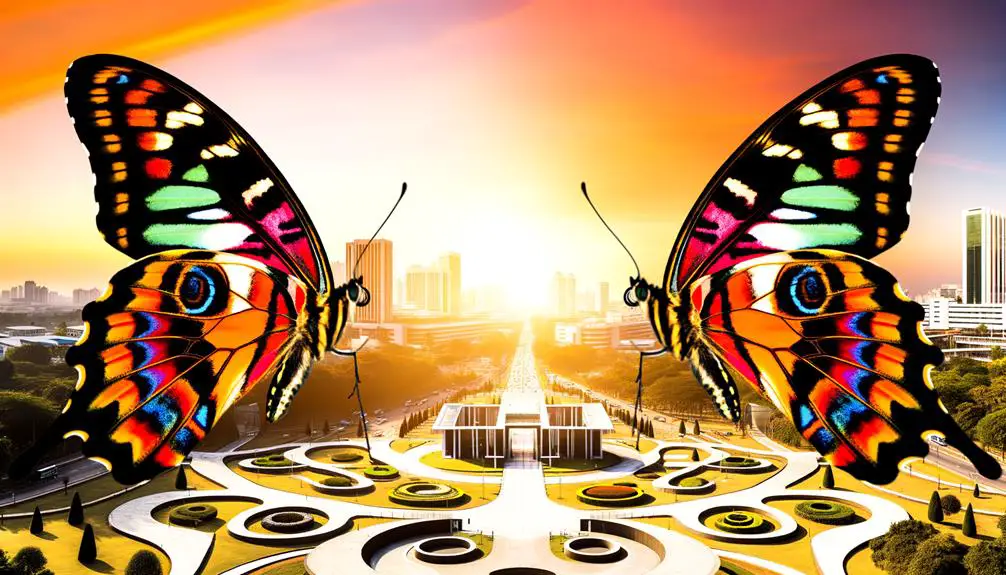
In contemporary culture, butterflies serve as powerful symbols representing transformation, freedom, and beauty, frequently appearing in various media and artistic forms.
Current artistic representations leverage the butterfly's vivid coloration and intricate patterns to evoke themes of change and renewal.
This section will explore how modern pop culture and the art world utilize the butterfly's imagery to convey complex narratives and emotional resonance.
Symbolism in Pop Culture
Contemporary pop culture often employs butterflies as symbols of transformation, freedom, and the ephemeral nature of beauty. This symbolic usage can be observed across various media, reflecting their delicate yet impactful presence.
Butterflies frequently manifest in the following contexts:
- Cinema and Television: Characters undergo significant personal growth or metamorphosis.
- Literature: Authors utilize butterflies to convey themes of change and fleeting moments.
- Fashion: Designs often incorporate butterfly motifs to evoke elegance and transience.
Such representations underscore the butterfly's role as a potent cultural metaphor, highlighting its ability to illustrate profound human experiences and emotions in contemporary narratives.
Artistic Representations Today
Modern interpretations of butterflies in art often leverage advanced techniques and materials to explore themes of metamorphosis and environmental fragility. Artists incorporate digital media, intricate paper sculptures, and bio-art installations to capture the delicate balance between transformation and vulnerability. By mimicking butterflies’ erratic flight patterns, some creators emphasize themes of unpredictability and chaos in nature. Others use sustainable materials to highlight the impact of environmental change on butterfly populations, reinforcing the connection between art and ecological awareness.
Artists employ mediums such as digital rendering, 3D printing, and mixed media to create intricate representations that capture the delicate balance of ecosystems.
These contemporary artworks frequently highlight the lifecycle of butterflies, emphasizing the stages from larva to adult, thereby symbolizing transformation and resilience.
Additionally, the inclusion of sustainable materials and eco-friendly practices reflects the growing awareness of environmental issues.
This intersection of art and science not only fosters a deeper appreciation for the natural world but also promotes conservation efforts by visually communicating the impacts of habitat destruction and climate change on butterfly populations.
Conclusion
The term 'butterfly' is a mosaic of linguistic evolution, ancient myths, and cultural superstitions, with roots in Old English and folklore.
The name likely stems from the butter-colored wings of certain species, while global variations reflect diverse linguistic influences.
Literary appearances and modern interpretations continue to shape understanding.
The etymology of 'butterfly' consequently emerges as a rich tapestry, woven from threads of history, language, and tradition, fluttering gracefully through the annals of time.







заработок на аккаунтах площадка для продажи аккаунтов
магазин аккаунтов платформа для покупки аккаунтов
магазин аккаунтов социальных сетей маркетплейс аккаунтов соцсетей
маркетплейс аккаунтов маркетплейс аккаунтов соцсетей
магазин аккаунтов безопасная сделка аккаунтов
перепродажа аккаунтов маркетплейс аккаунтов
магазин аккаунтов продажа аккаунтов соцсетей
Profitable Account Sales Buy and Sell Accounts
Account Store Account Selling Service
Secure Account Purchasing Platform Find Accounts for Sale
Account Market Account exchange
Database of Accounts for Sale Secure Account Sales
Gaming account marketplace Marketplace for Ready-Made Accounts
Ready-Made Accounts for Sale Database of Accounts for Sale
Buy accounts Account marketplace
Buy accounts Accounts marketplace
Account Catalog https://socialmediaaccountsale.com/
accounts market account market
account sale account exchange
account market buy and sell accounts
account catalog online account store
account exchange website for selling accounts
marketplace for ready-made accounts account trading platform
account selling platform buy pre-made account
account market verified accounts for sale
account trading service account purchase
buy accounts profitable account sales
account catalog accounts for sale
account acquisition account exchange
gaming account marketplace account selling service
account trading service account store
ready-made accounts for sale account selling platform
account marketplace account trading platform
sell accounts ready-made accounts for sale
marketplace for ready-made accounts purchase ready-made accounts
social media account marketplace profitable account sales
ready-made accounts for sale marketplace for ready-made accounts
website for buying accounts guaranteed accounts
account trading service sell account
account purchase account catalog
online account store account buying platform
account buying service accounts-store.org
secure account sales social media account marketplace
buy accounts account acquisition
verified accounts for sale guaranteed accounts